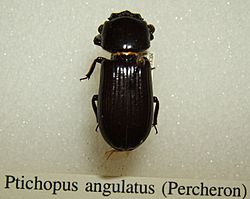Ptichopus angulatus facts for kids
Quick facts for kids Ptichopus angulatus |
|
|---|---|
 |
|
| Ptichopus angulatus, adult | |
| Scientific classification | |
| Kingdom: | |
| Phylum: | |
| Class: | |
| Order: | |
| Family: |
Passalidae
|
| Genus: |
Ptichopus
|
| Species: |
P. angulatus
|
| Binomial name | |
| Ptichopus angulatus (Percheron)
|
|
Ptichopus angulatus is a type of beetle that belongs to the Passalidae family. These beetles are often called "bess beetles" or "patent leather beetles" because of their shiny, black appearance. They are fascinating insects known for living in groups and even making sounds!
Contents
What is Ptichopus angulatus?
Ptichopus angulatus is a medium-sized beetle. It has a very hard, shiny body that looks almost like polished leather. Most beetles in the Passalidae family are dark brown or black. They have strong jaws, called mandibles, which they use for chewing wood.
Where Do These Beetles Live?
These beetles love to live in forests. You can usually find them inside decaying or rotting logs and stumps. They are important for the forest ecosystem because they help break down dead wood. This process returns nutrients to the soil, helping new plants grow.
What Do They Eat?
Ptichopus angulatus beetles are detritivores. This means they eat decaying plant material, especially rotting wood. Both the adult beetles and their young, called larvae, feed on this soft, decomposing wood. They have special bacteria in their guts that help them digest the tough wood fibers.
A Family of Beetles
One of the most interesting things about Ptichopus angulatus and other bess beetles is their social behavior. Unlike many other beetles, they live in family groups. The adult male and female beetles often stay together with their larvae and pupae (the stage before becoming an adult). They even work together to prepare the wood for their young to eat. This kind of family life is quite rare for insects!
Making Sounds
Bess beetles are also known for being "singing" beetles. They can make at least 14 different kinds of sounds! They produce these sounds by rubbing parts of their body together, a process called stridulation. They use these sounds to communicate with each other, perhaps to warn of danger or to help the family group stay together.
The Life Cycle of a Beetle
Like all beetles, Ptichopus angulatus goes through a complete metamorphosis.
- Eggs: The female beetle lays her eggs inside the rotting wood.
- Larvae: Tiny larvae hatch from the eggs. These larvae are soft, C-shaped grubs. They feed on the wood that the adult beetles have chewed up for them.
- Pupae: After growing, the larvae change into pupae. This is a resting stage where the beetle transforms into its adult form.
- Adults: Finally, the adult beetle emerges from the pupa. It will then find a mate and start the cycle all over again. The whole family often stays together throughout these stages.
Gallery
See also
 In Spanish: Ptichopus angulatus para niños
In Spanish: Ptichopus angulatus para niños


